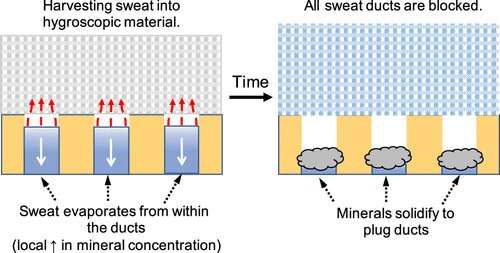Turning sweat against itself with a metal-free antiperspirant

Body odor is an unpleasant smell, produced when bacteria living on the skin break down the proteins in sweat. To avoid stinking, some people apply antiperspirants that clog sweat ducts with foreign materials, such as metals, to slow perspiration. As a step toward a more natural solution, researchers reporting in ACS Applied Materials & Interfaces have turned sweat against itself using an evaporation-based approach in which the salts in sweat create a gel-like plug.
Most commercial antiperspirants use metallic salts, such as aluminum chlorohydrate, to clog sweat ducts. Years ago, it was suggested that using these products could increase the risk of developing breast cancer, but according to the National Cancer Institute, no scientific evidence exists that confirm those claims. Nevertheless, consumer and regulatory demand has increased for natural, non-metallic alternatives. Because propylene glycol strongly attracts water and is "generally recognized as safe" by the U.S. Food & Drug Administration, Jonathan Boreyko and colleagues wanted to see if it would draw the water out of sweat, leaving behind a natural salt blockade that would stop the flow.
To simulate a sweat duct in the laboratory, the researchers slowly pushed an artificial sweat solution through a thin glass tube. Then, they placed a polymer cube covered in propylene glycol near the opening. The sweat solution initially bubbled, then formed a gel-like plug that obstructed the tube within two minutes. However, when the cube did not contain propylene glycol or the cube was absent, sweat continually exited the outlet and ran along the outside surface of the tube. The team used glass tubes that were 3.3 times wider than real sweat ducts in human skin, but their models suggest that applying a propylene glycol film directly on skin would also result in dehydrated salts and plug formation. The next step in this research would be to conduct human trials to compare the comfort and effectiveness of a film made of propylene glycol, or other water-attracting materials, against traditional metal-based antiperspirants, the researchers say.
More information: Venkata Yashasvi Lolla et al. Evaporation-Induced Clogging of an Artificial Sweat Duct, ACS Applied Materials & Interfaces (2020). DOI: 10.1021/acsami.0c13493
Journal information: ACS Applied Materials and Interfaces
Provided by American Chemical Society





















